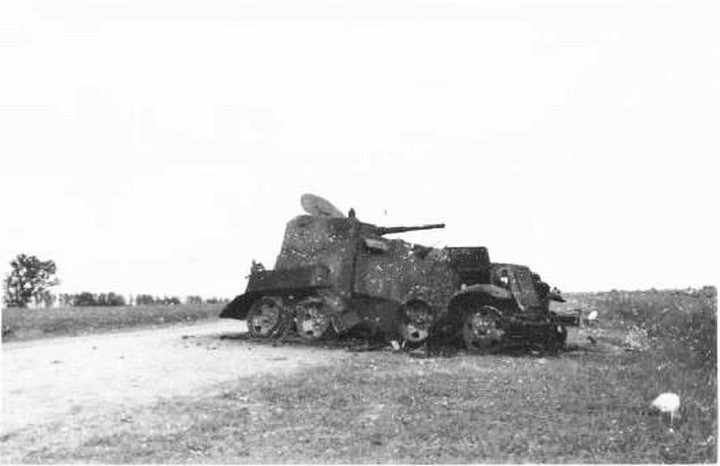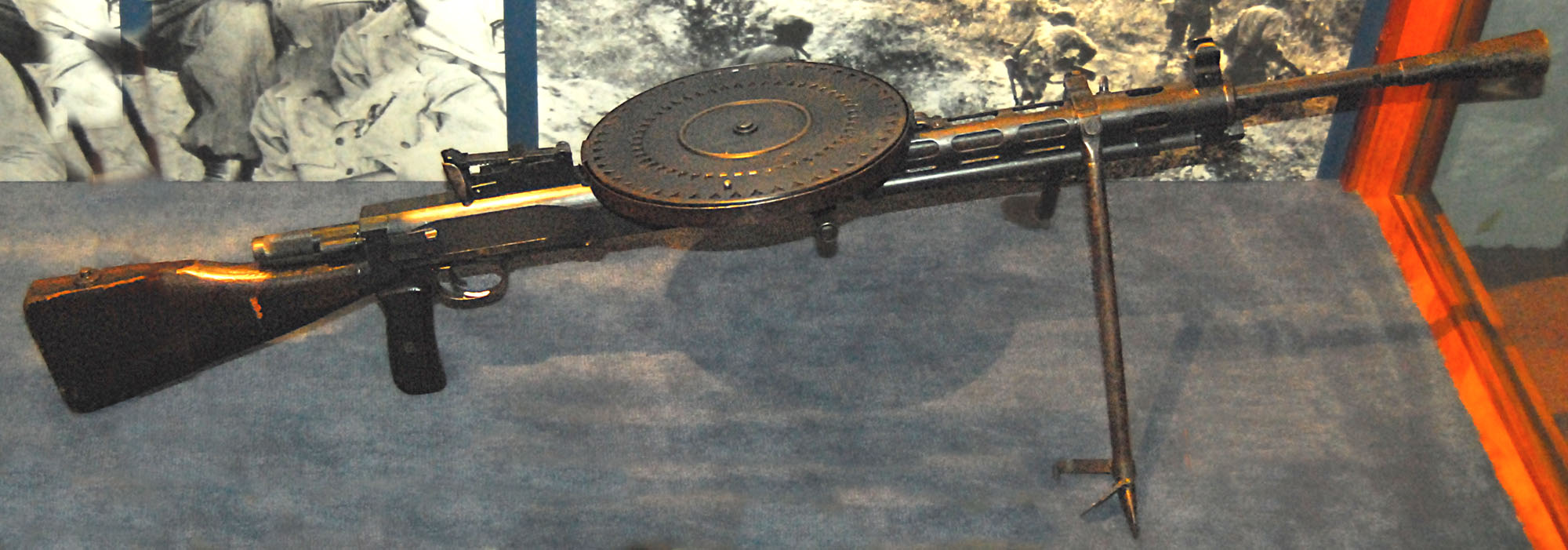|
BA-11
The BA-11 or Broneavtomobil 11 () was an armored car developed in the Soviet Union. It was intended to replace the BA-10, but production was prevented by the Nazi German invasion of 1941. The BA-11 was a heavy armored car designed based on a strengthened ZiS-6K chassis. Used during 1941–1942 on the Leningrad front, it was designed to attack infantry, cavalry, and medium armored cars. With 13mm of frontal armour, it was only slightly less protected than the most common Soviet light tank of the era, the T-26 The T-26 tank was a Soviet light tank used during many conflicts of the Interwar period and in World War II. It was a development of the British Vickers 6-Ton tank and was one of the most successful tank designs of the 1930s until its light ..., which had 15mm of armour. It had very poor off-road mobility due to being overloaded and lacking all wheel drive, so only 17 were built and all of them were lost in 1941–42. One BA-11 was modified with ZiS D-7 96hp dies ... [...More Info...] [...Related Items...] OR: [Wikipedia] [Google] [Baidu] |
BA-10
The BA-10 ( ru , Broneavtomobil 10, italic=yes) was an armored car developed in the Soviet Union in 1938 and produced through 1941. It was the most produced Soviet pre-1941 heavy armored car – 3311 were built in three versions. These versions were the BA-10, the BA-10M (improved version with new radio), and the BA-10ZhD (equipped for dual railway/road use). The basic BA-10 design was developed from the BA-3 and BA-6 heavy armored cars. It had an improved GAZ-AAA chassis and improved armor (up to 15mm at front and turret). It was intended that the BA-10 would be replaced in 1941 by the BA-11 with diesel engine and more sophisticated armor design, but the outbreak of war prevented BA-11 production. The BA-10 was in Red Army service until 1945. Significant numbers of captured BA-10s were used by Finland (at least 24), Germany and other Axis powers in Europe. Development During the late 1930s, Soviet armoured fighting vehicle designers incorporated sloped armor into all their ... [...More Info...] [...Related Items...] OR: [Wikipedia] [Google] [Baidu] |
45 Mm Anti-tank Gun M1932 (20-K)
The 45 mm anti-tank gun model 1932 (factory designation 19-K and GRAU index 52-P-243A) was a light quick-firing anti-tank gun used in the interwar period and in the first stage of the German-Soviet War. It was created by factory No. 8 which was located in now Korolyov city, under leadership of engineer V. Bering. History The gun bearing factory designation 19-K (Cyrillic ''19-К'') was a combination of a modified carriage of the 37 mm anti-tank gun model 1930 (built according to a documentation bought from Rheinmetall) with a 45 mm barrel designed in March 1932. and adopted by the Red Army on March 23, 1932. The 45 mm caliber was selected because the large reserves of the French 47 mm shells could be converted to 45 mm by milling out the driving bands. The resulting light quarter-automatic anti-tank gun was discovered to be unsatisfactory due to low mobility and reliability problems, and after a series of modifications (including the arrest of ... [...More Info...] [...Related Items...] OR: [Wikipedia] [Google] [Baidu] |
Armored Car (military)
A military armored (or armoured) car is a lightweight wheeled armored fighting vehicle, historically employed for reconnaissance, internal security, armed escort, and other subordinate battlefield tasks. With the gradual decline of mounted cavalry, armored cars were developed for carrying out duties used to be assigned to light cavalry. Following the invention of the tank, the armored car remained popular due to its faster speed, comparatively simplified maintenance and low production cost. It also found favor with several colonial armies as a cheaper weapon for use in underdeveloped regions. During World War II, most armored cars were engineered for reconnaissance and passive observation, while others were devoted to communications tasks. Some equipped with heavier armament could even substitute for tracked combat vehicles in favorable conditions—such as pursuit or flanking maneuvers during the North African Campaign. Since World War II the traditional functions of t ... [...More Info...] [...Related Items...] OR: [Wikipedia] [Google] [Baidu] |
DT Machine Gun
The Degtyaryov machine gun (russian: Пулемёт Дегтярёвa Пехотный, Pulemyot Degtyaryova Pekhotny literally: "Degtyaryov's infantry machine gun") or DP-27/DP-28 is a light machine gun firing the 7.62×54mmR cartridge that was primarily used by the Soviet Union, with service trials starting in 1927, followed by general deployment in 1928. Besides being the standard Soviet infantry light machine gun (LMG) during World War II, with various modifications it was used in aircraft as a flexible defensive weapon, and it equipped almost all Soviet tanks in WWII as either a flexible bow machine gun or a co-axial machine gun controlled by the gunner. It was improved in 1943 producing the DPM, but it was replaced in 1946 with the RP-46 which improved on the basic DP design by converting it to use belt feed. The DP machine gun was supplemented in the 1950s by the more modern RPD machine gun and entirely replaced in Soviet service by the general purpose PK machine gun in t ... [...More Info...] [...Related Items...] OR: [Wikipedia] [Google] [Baidu] |
Soviet Union
The Soviet Union,. officially the Union of Soviet Socialist Republics. (USSR),. was a transcontinental country that spanned much of Eurasia from 1922 to 1991. A flagship communist state, it was nominally a federal union of fifteen national republics; in practice, both its government and its economy were highly centralized until its final years. It was a one-party state governed by the Communist Party of the Soviet Union, with the city of Moscow serving as its capital as well as that of its largest and most populous republic: the Russian SFSR. Other major cities included Leningrad (Russian SFSR), Kiev (Ukrainian SSR), Minsk ( Byelorussian SSR), Tashkent (Uzbek SSR), Alma-Ata (Kazakh SSR), and Novosibirsk (Russian SFSR). It was the largest country in the world, covering over and spanning eleven time zones. The country's roots lay in the October Revolution of 1917, when the Bolsheviks, under the leadership of Vladimir Lenin, overthrew the Russian Provisional Government ... [...More Info...] [...Related Items...] OR: [Wikipedia] [Google] [Baidu] |
Operation Barbarossa
Operation Barbarossa (german: link=no, Unternehmen Barbarossa; ) was the invasion of the Soviet Union by Nazi Germany and many of its Axis allies, starting on Sunday, 22 June 1941, during the Second World War. The operation, code-named after Frederick Barbarossa ("red beard"), a 12th-century Holy Roman emperor and German king, put into action Nazi Germany's ideological goal of conquering the western Soviet Union to repopulate it with Germans. The German aimed to use some of the conquered people as forced labour for the Axis war effort while acquiring the oil reserves of the Caucasus as well as the agricultural resources of various Soviet territories. Their ultimate goal was to create more (living space) for Germany, and the eventual extermination of the indigenous Slavic peoples by mass deportation to Siberia, Germanisation, enslavement, and genocide. In the two years leading up to the invasion, Nazi Germany and the Soviet Union signed political and economic pacts for st ... [...More Info...] [...Related Items...] OR: [Wikipedia] [Google] [Baidu] |
T-26
The T-26 tank was a Soviet light tank used during many conflicts of the Interwar period and in World War II. It was a development of the British Vickers 6-Ton tank and was one of the most successful tank designs of the 1930s until its light armour became vulnerable to newer anti-tank guns.Franco, ''El Tanque de la Guerra Civil Española'', p. 74. It was produced in greater numbers than any other tank of the period, with more than 11,000 units manufactured. During the 1930s, the USSR developed 53 variants of the T-26, including flame-throwing tanks, combat engineer vehicles, remotely controlled tanks, self-propelled guns, artillery tractors, and armoured carriers. Twenty-three of these were series-produced, others were experimental models. The T-26 and BT were the main tanks of the Red Army's armoured forces during the interwar period. The T-26 was the most important tank of the Spanish Civil War and played a significant role during the Battle of Lake Khasan in 1938, as well ... [...More Info...] [...Related Items...] OR: [Wikipedia] [Google] [Baidu] |
World War II Armoured Cars
In its most general sense, the term "world" refers to the totality of entities, to the whole of reality or to everything that is. The nature of the world has been conceptualized differently in different fields. Some conceptions see the world as unique while others talk of a "plurality of worlds". Some treat the world as one simple object while others analyze the world as a complex made up of many parts. In ''scientific cosmology'' the world or universe is commonly defined as " e totality of all space and time; all that is, has been, and will be". '' Theories of modality'', on the other hand, talk of possible worlds as complete and consistent ways how things could have been. ''Phenomenology'', starting from the horizon of co-given objects present in the periphery of every experience, defines the world as the biggest horizon or the "horizon of all horizons". In ''philosophy of mind'', the world is commonly contrasted with the mind as that which is represented by the mind. ''Th ... [...More Info...] [...Related Items...] OR: [Wikipedia] [Google] [Baidu] |


.jpg)

.jpg)

